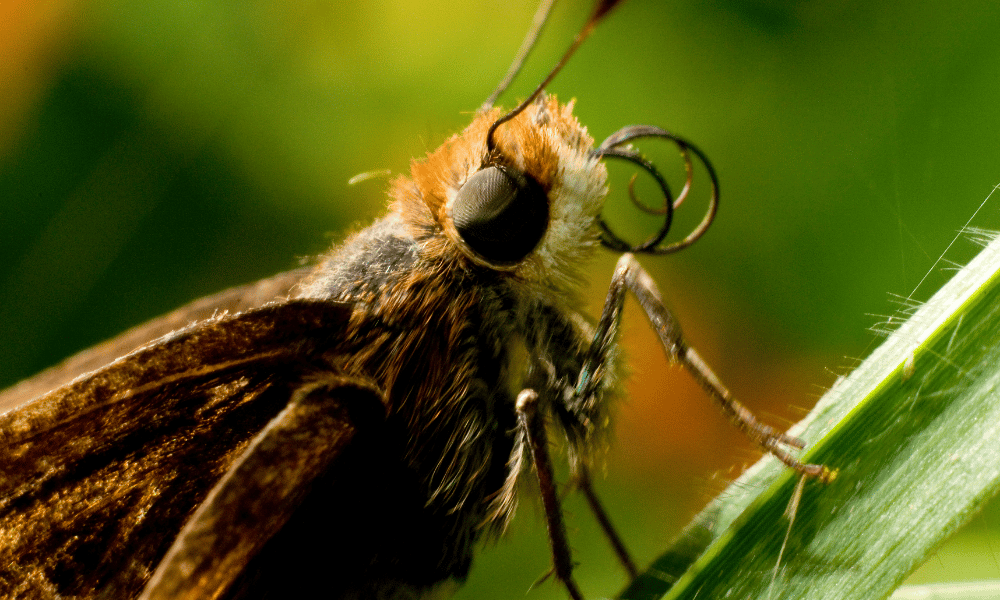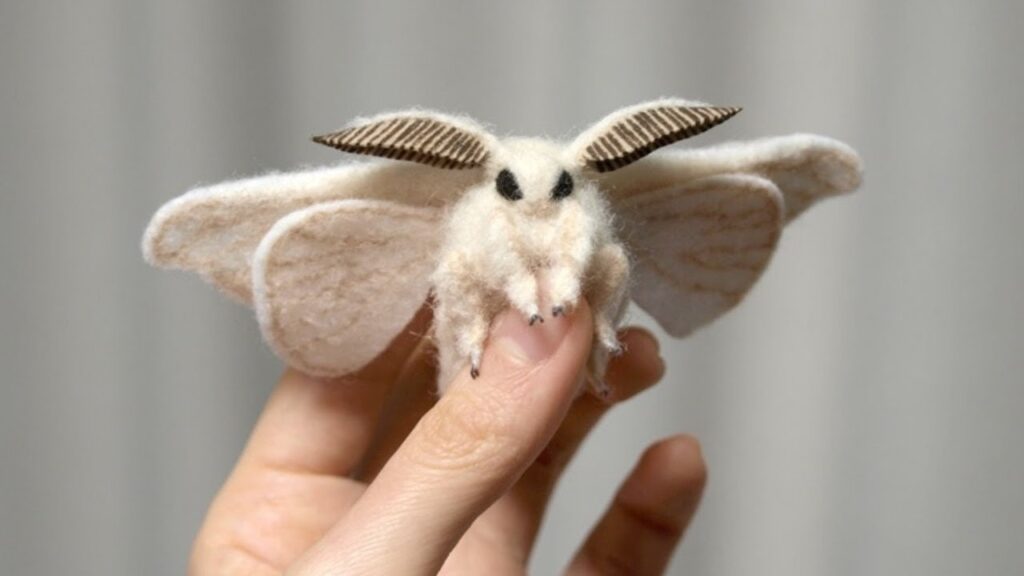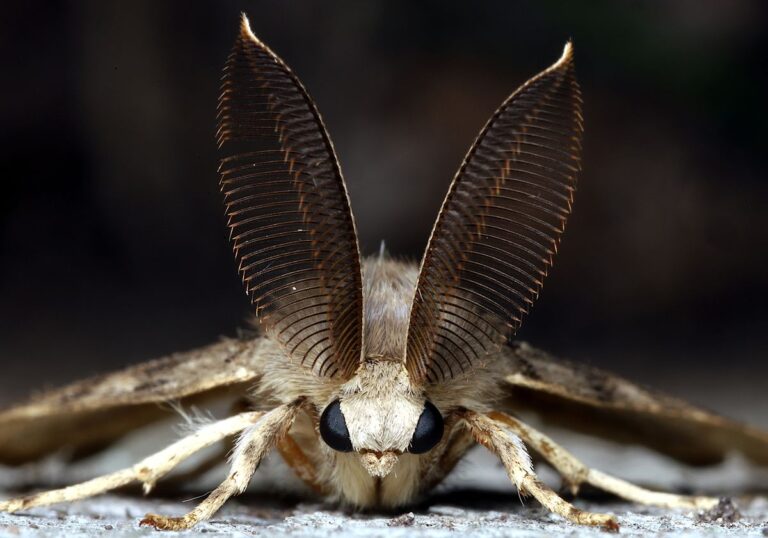Moths can’t hear like humans, but they can sense sounds and vibrations through specialized structures called tympanal organs.
Additionally, these organs, usually on their abdomen or thorax, vibrate when exposed to sound waves, allowing moths to detect sounds and potential threats or mates. Moths’ hearing is less advanced than that of mammals or birds.
How do tympanal organs work?
The specific adaptations and variations in tympanal organ structure can provide insights into the ecological roles and behaviors of different moth species.
Tympanal Organs
Tympanal organs in moths are thin, delicate structures that serve as the primary hearing apparatus. They are typically composed of a membrane or tympanic membrane stretched over an air sac.
Furthermore, this membrane is incredibly sensitive to even subtle vibrations in the surrounding air.
Location of Tympanal Organs on a Moth’s Body
The placement of tympanal organs can vary among moth species but is commonly found on the abdomen or thorax. Some moths may have multiple pairs of these organs, enhancing their ability to detect sounds from different directions.
In addition, the exact positioning and structure of tympanal organs can be species-specific and may play a role in their specific ecological niches and behaviors.
Mechanism of Sound Detection

When sound waves, which are essentially oscillations in air pressure, reach the moth, they cause the tympanic membrane to vibrate.
The vibration of this membrane is highly responsive to even faint sounds, thanks to its sensitivity.
The ability of the membrane to vibrate allows moths to detect auditory cues in their environment.
Transduction of Sound into Neural Signals
As the tympanic membrane vibrates, it transfers these mechanical vibrations into neural signals. Mechanoreceptor cells beneath or adjacent to the membrane are responsible for detecting these vibrations and converting them into electrical signals.
Nerve pathways then transmit these electrical signals to the moth’s brain, where they are processed and interpreted. The brain deciphers the frequency and intensity of the sound, enabling the moth to perceive and potentially react to it.
What sounds can moths perceive?
These abilities are the result of complex adaptations that have evolved over time to meet the specific ecological challenges faced by different moth species.
Range of Frequencies Detected
The Spectrum of Sounds Moths Can Perceive: Moths typically have a relatively broad range of frequencies they can detect, covering sounds in the ultrasonic and lower audible ranges.
Some moths are especially sensitive to ultrasonic sounds, which are beyond the range of human hearing. This sensitivity is crucial for detecting echolocation calls of bats, which are common predators of moths.
Moreover, the ability to hear both high and low-frequency sounds allows moths to perceive a wide variety of environmental cues.
Limitations in Their Hearing Range: While moths can detect a wide spectrum of sounds, they may have limitations in their hearing range.
The sensitivity and responsiveness of their tympanal organs may vary across species, impacting their ability to detect specific frequencies.
Additionally, environmental factors such as background noise and the presence of other insects or animals can affect the practical hearing range of moths.
How Moths Use Sound to Locate Objects or Mates?
Moths use sound not only for hearing potential threats (predators) but also for locating objects and mates. Sound source localization is the ability to determine the direction from which a sound is coming.
Moreover, moths can achieve this by comparing the timing and intensity of sound signals received by their two tympanal organs (if they have two pairs). Differences in the arrival time and intensity of sound at each ear can help moths pinpoint the source of the sound.
Adaptations for Directional Hearing
Moths have evolved adaptations for effective directional hearing. The arrangement and structure of their tympanal organs, including the size and shape of the air sacs behind the membranes, can influence the directionality of their hearing.
In addition, some moths have asymmetrical tympanal membranes, which further enhance their ability to detect the direction of sound sources.
Moreover, these adaptations help moths navigate their environment, locate potential mates by listening for their mating calls, and evade predators more effectively.
How does moth hearing compare to human hearing?
Moths’ hearing mechanisms, while different from human hearing, are finely tuned to their ecological needs
Contrasting Moth Hearing with Human Hearing
Differences in Hearing Organs and Mechanisms : Humans have highly specialized ears with three main parts: the outer ear, middle ear, and inner ear. Sound waves are funneled through the ear canal, causing the eardrum to vibrate, which is then transmitted to the inner ear for processing.
In contrast, moths lack ears in the conventional sense. They rely on tympanal organs, which are sensitive membranes stretched over air sacs, for hearing. These organs detect vibrations directly, without the need for a middle ear or inner ear like humans.
Furthermore, the absence of a middle and inner ear allows moths to perceive sounds differently, particularly when it comes to detecting vibrations in the air.
Sensory Advantages and Disadvantages
Moths’ tympanal organs are exceptionally sensitive to even faint sounds and vibrations in their environment. This sensitivity is advantageous for detecting predators such as bats, which emit high-frequency ultrasonic sounds during hunting.
However, moths may have limited capacity for detailed sound discrimination compared to humans, whose complex auditory system allows them to distinguish a wide range of frequencies and nuances in sound.
Moths’ hearing is finely tuned for specific ecological needs, such as predator avoidance and mate attraction, rather than general-purpose hearing like humans.
Similarities with Other Insects
Comparing Moth Hearing to Other Insect Species: While moths have specialized tympanal organs, other insects, such as certain grasshoppers and crickets, also possess similar structures for sound detection.
Moreover, these hearing structures can vary in location and design among different insect species, reflecting their specific needs and habitats.
In addition, the diversity of insect hearing mechanisms offers insights into the evolution of auditory adaptations in the insect world.
Evolutionary Significance: Insect hearing has evolved independently in multiple lineages, showcasing its adaptive value in diverse ecological contexts.
However, the development of hearing organs in insects has likely played a pivotal role in their interactions with the environment, influencing their survival, communication, and predator-prey relationships.
Studying the similarities and differences in insect hearing can provide valuable information about the convergent evolution of sensory adaptations in the animal kingdom.
How do moths use hearing to avoid predators?

Their ability to detect predators, locate mates, and respond to acoustic cues is a testament to the diverse ways in which hearing has evolved in the animal kingdom
Predation Avoidance
Moths primarily use their hearing abilities to detect the ultrasonic echolocation calls of bats, their main predators. When moths perceive bat calls, they often engage in evasive maneuvers, such as rapid flight or erratic flight patterns, to avoid being captured.
Moreover, some moths have evolved the ability to produce ultrasonic clicks or noises in response to bat calls, possibly as a form of acoustic mimicry or jamming to confuse bats.
Escaping Strategies
Moths employ a range of escaping strategies, not solely relying on their hearing.
Visual cues, such as moonlight or artificial light sources, can also guide their flight behavior.
Chemical defenses, including the release of defensive compounds or pheromones, may be used in conjunction with auditory responses to deter predators.
Mate Attraction
The Role of Hearing in Moth Mating Rituals: Moth species that engage in acoustic communication rely on hearing for mate attraction.
Male moths typically produce specific sounds or mating calls, which are species-specific and act as signals to attract females.
Females, equipped with hearing structures similar to males, can identify and locate potential mates based on these calls.
Signal Production and Reception :
Male moths produce mating calls through specialized structures, such as tymbals or stridulatory organs, which generate sound by rapid movement or friction.
Furthermore, the ability to produce and perceive these calls accurately is crucial for reproductive success. Variations in call characteristics can play a role in mate choice and species recognition.
FAQ’s
Do moths respond to sound?
Yes, moths can respond to sounds and vibrations in their environment through specialized structures known as tympanal organs.
Can moths see or hear?
Moths primarily rely on their sense of hearing, using tympanal organs, but they also have simple eyes that can detect light and darkness.
How low can a moth hear?
Moth hearing can encompass a broad range of frequencies, but the specific lower limit can vary depending on the moth species.
Do moths have feelings?
Moths do not have emotions or feelings in the way humans do; their behaviors are largely instinctual responses to environmental cues.
Do moths feel pain?
Moths do not possess the neurological complexity to experience pain as higher animals do.
Are moths silent?
Moths themselves do not produce audible sounds for communication. They are generally considered silent insects.
Are moths shy?
Moths are not typically described as “shy” since their behaviors are driven by survival and reproductive instincts, rather than social interactions.
What animal has the lowest hearing?
Among animals with specialized hearing, some of the animals with the lowest hearing abilities are certain species of deep-sea fish, which have adapted to low-frequency sounds in the ocean’s depths.
Final Words
In short, moths have an amazing way of hearing even though they don’t have regular ears like humans. They use special parts called “tympanal organs,” which are like sensitive membranes stretched over tiny air sacs.
These organs help them hear a wide range of sounds, from high-pitched ones to lower ones, depending on the type of moth. Moths can also figure out where sounds are coming from, which helps them stay safe from predators and find mates.
This hearing system is different from how humans hear because moths don’t have middle and inner ears like we do, but it works really well for what they need.
When we compare how moths hear to how other animals and insects hear, we see both differences and similarities. These comparisons help us understand how hearing has evolved in the animal world.
Moths also use their hearing in important ways for their lives. They listen for sounds like bats, their main predators, and try to escape from them.
Additionally, moths use their hearing to find mates by making special sounds. All of these adaptations show how crucial hearing is for moths in their environment.

